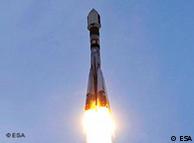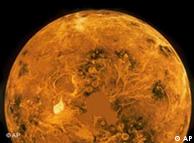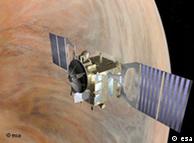For about a decade, Venus has been virtually ignored. But the European Space Agency wants to change that, and has successfully sent the Venus Express into orbit around the second planet from the sun.
Venus, named for a goddess and Earth's closest neighbour has been unexplored for more than a decade, left alone to silently circle the Sun, remaining a planet as cryptic as it is hostile.
But this changed on Tuesday when a European Space Agency probe successfully entered orbit around Venus after a 400-million-kilometer (250-million-mile) trip.
Its mission is to remain in orbit around this pressure-cooker of a planet for nearly three years, peering into the toxic clouds that shroud it in a bid to answer questions that are immensely relevant to us on Earth.
But good luck has never been a factor in the exploration of Venus.
The planet of love
The planet that carries such welcoming names -- the Shepherd Star, the Morning Star, the Planet of Love -- is also the graveyard of dreams.
In a long litany of failed missions, the most successful has been the US orbiter Magellan, which radar-mapped 98 percent of the planet's surface. It ended in October 1994.
 Bildunterschrift: Großansicht des Bildes mit der Bildunterschrift: The mission is expected to last three years
Bildunterschrift: Großansicht des Bildes mit der Bildunterschrift: The mission is expected to last three years
Since then, scorching Venus has been snubbed. Mankind has favored exploration of Mars and the mighty outer planets, the gatekeepers of the Solar System.
Now interest in Venus has suddenly revived.
Insights for earth
Venus, so close, so similar in size to Earth, appears to be an example of runaway global warming, of a weather system that works in a vicious circle to store up solar heat.
Understanding the physics of this could yield precious insights for Earth, where man-made global warming, driven by fossil fuels, is a looming danger.
Many scientists worry about so-called positive feedback -- the Earth's own vicious circle, in which vast stores of carbon dioxide (CO2) locked in the permafrost could be released by higher temperatures.
The release would worsen the greenhouse effect, and in turn further fuel global warming, magnifying climate change and possibly making it unstoppable for centuries to come.
Orbiting is a complex maneuver
Launched from Russia's space base at Baikonur on November 9, the European Space Agency's 220-million-euro ($264 million) probe had to perform a precise series of manoeuvres in order to be captured in orbit.
"Venus orbit insertion is a complex step," said Jean-Baptiste Gratadour, attitude and orbital control systems engineer at ESA's Space Operations Centre in Darmstadt, Germany. "The main challenge is that the manoeuvre must happen at the right time."
The probe's main engine was switched on for 50 minutes to help reduce its speed and allow it to be caught in Venus's gravitational pull, said controllers.
"Fantastic moment. We are finally around Venus," said mission chief Don McCoy at 0808 GMT during a video broadcast at ESA headquarters in Paris.
 Bildunterschrift: Großansicht des Bildes mit der Bildunterschrift: Venus does not reveal her mysteries easily
Bildunterschrift: Großansicht des Bildes mit der Bildunterschrift: Venus does not reveal her mysteries easily
Further engine "burns" will be needed over the coming weeks to fine-tune the orbital track.
The goal is that, by early May, the scout will be placed in an elliptical orbit, swooping to as low as 250 kilometers above the surface to a height of 66,000 kilometers.
The Venus Express -- a virtual copy of the Mars Express now orbiting the Red Planet -- carries seven powerful instruments designed to tear away the veil that is the complex Venusian atmosphere.
The payload includes sensors to track the planet's multilayered, roiling clouds in visible light, infra-red and ultraviolet.
They will also measure the atmosphere's temperature and chemical composition and analyze its intriguing magnetic field, caused by interaction with the "solar wind" of particles blasted out by the Sun.
The mission has enough fuel to operate for 1,000 Earth days, ESA's Web site said.
